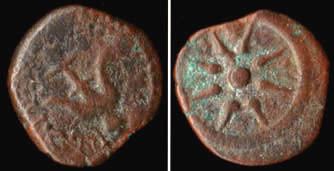 | ||
The Lesson of the widow's mite is presented in the Synoptic Gospels (Mark 12:41-44, Luke 21:1-4), in which Jesus is teaching at the Temple in Jerusalem. The Gospel of Mark specifies that two mites (Greek lepta) are together worth a quadrans, the smallest Roman coin. A lepton was the smallest and least valuable coin in circulation in Judea, worth about six minutes of an average daily wage.
Contents
In the story, a widow donates two small coins, while wealthy people donate much more. Jesus explains to his disciples that the small sacrifices of the poor mean more to God than the extravagant, but proportionately lesser, donations of the rich.
The King James Bible translation
In Jesus' times in Palestine, the small copper coin was called a lepton; there was no coin called by the English term "mite" at that time. However, there was a mite in the time of the creation of the King James Bible, as indeed there had been at the time of earliest modern English translation of the New Testament by William Tyndale in 1525. The denomination was well known in the Southern Netherlands. Both the duke of Brabant and the count of Flanders issued them and they were sometimes imitated in the North. English poet Geoffrey Chaucer refers to the myte in his unfinished poem Anelida and Arcite (c. 1370). Originally, the Brabant mijt (maille in French) was 1/76 stuiver, the Flemish mijt 1/48 stuiver. When the two areas were united under the dukes of Burgundy and later under the Habsburgs, the rate of the mijt was set at 1/32 stuiver. More important, they were the very smallest copper coins. By 1611, they were no longer minted, but they were still in circulation.
Explanation
We do not know what portion of her income the woman gave. The wealthy man gave more money, but it very well might have been a smaller percentage of his total income than the woman gave. Also, the widow sacrificially gave from her heart, whereas the man gave to show off his wealth and to feign being religious. This was to show that God desires a voluntary, cheerful giver rather than one who gives to show off and feign piety.
In the passage immediately preceding this in both Gospel accounts, Jesus is portrayed as condemning the religious leaders who feign piety, accept honor from people, and steal from widows (perhaps feigning piety in order to gain the trust of widows, and thereby gain access to their assets). Although most Christians understand this as criticism of the actions of certain individuals, racist groups have historically argued that the passages in question justify anti-semitism, particularly as the Gospel of Mark argues that severe punishment awaits those who follow such actions.
